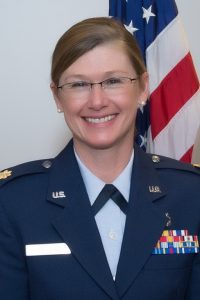Greetings to all our readers from the Policy Chair and Treasurer-Elect of the NPWH Board of Directors. Before you read my first Policy & practice points column, in which I aim to provide insight into policies affecting women who serve in the military from the perspective of a woman serving in the military, I want to introduce myself. I am a women’s health nurse practitioner (WHNP) and a Lieutenant Colonel in the United States Air Force (USAF). I have 13 years’ experience serving in the military as a WHNP. I have served in multiple locations, including highly operational positions where I have supported military women worldwide. I now serve in the largest research organization in the USAF, where I am developing solutions to better incorporate women into the armed services.
 Since completing my master’s and doctoral degrees and becoming a WHNP in 2006 and joining the Air Force,I have deployed abroad multiple times, supporting combat operations in Afghanistan and serving on humanitarian and educational missions in Panama and Vietnam. During my deployments, I supplied women with birth control methods to match their needs in their deployed settings. I also addressed menstrual suppression and performed abnormal uterine bleeding evaluations, various cancer screenings, and specialty-related procedures such as intrauterine device insertions and endometrial biopsies. These needs are common among military women during deployment. In an often chaotic and rapidly changing military environment both at home and abroad, the most valuable resource a WHNP provides is continuity and consistency in situations where standards and guidelines frequently change and where multiple visits or follow-up laboratory tests are important.
Since completing my master’s and doctoral degrees and becoming a WHNP in 2006 and joining the Air Force,I have deployed abroad multiple times, supporting combat operations in Afghanistan and serving on humanitarian and educational missions in Panama and Vietnam. During my deployments, I supplied women with birth control methods to match their needs in their deployed settings. I also addressed menstrual suppression and performed abnormal uterine bleeding evaluations, various cancer screenings, and specialty-related procedures such as intrauterine device insertions and endometrial biopsies. These needs are common among military women during deployment. In an often chaotic and rapidly changing military environment both at home and abroad, the most valuable resource a WHNP provides is continuity and consistency in situations where standards and guidelines frequently change and where multiple visits or follow-up laboratory tests are important.
Current challenges facing military healthcare policymakers involve determining the right combination of specialty versus primary care, as well as determining any healthcare that can be provided by civilians in the local community. Although cost and availability of military-versus civilian-provided care would seem to be the most important metrics when determining the best avenue for care, the situation is more complicated than that. Military service can involve worldwide travel, with no notice, to regions without specialty or comprehensive primary care services. The timing and scheduling logistics associated with the need for laboratory tests/results prior to performing certain procedures and the importance of awaiting pathology results from screenings before sending someone to a place where follow-up care would be unavailable are all critically important to WHNPs serving in the military.
Many women have needed to return home or to go to facilities beyond their deployed locations—for example, to Germany—to obtain appropriate care because of a variety of lost opportunities associated with cervical dysplasia screening (e.g., misinterpreted results at the home station, missed screening among high-risk populations prior to deployment). Dysplasia management is not complicated, but it is unforgiving if continuity and consistency of care cannot be sustained.
Dedicated women’s health services excel at ensuring consistency and continuity to such a degree that we in the military refer to them as force multipliers. For example, having a nutritionist at our location is not explicitly necessary, although our high-performance Special Operations units rely on nutritionists to ensure their members have the “fuel” they need to succeed for long durations in harsh environments, thereby multiplying the effect of those forces. Similarly, WHNPs are force multipliers within the military health system because they ensure that women are screened and treated appropriately at home prior to deployment and are not returning home early for avoidable reasons.

What makes serving in the military as a healthcare provider (HCP) unique is the relationship between the member requiring care and her commander, who is responsible for ensuring that her members are ready to deploy at a moment’s notice. Fully understanding and being sensitive to the physical requirements of the military mission to determine whether and how a member can participate in a deployment is the core difference between military and civilian healthcare delivery. In many cases, an ongoing dialogue with a member’s commander is necessary to ensure that the commander’s worldwide mission is supported while a member’s healthcare needs are met. Dedicated women’s health services ensure that women can participate in unique military missions as seamlessly as possible, thereby reducing organizational reluctance to allow women to participate as broadly as possible. Policies allowing women to participate as Air Force pilots, Navy submariners, Army Rangers, and many more combatant roles depend on women being consistently available to perform their important duties. Female military members depend on women’s health services—provided by either a civilian or a military provider—being the force multiplier that maintains their readiness to participate in those challenging missions.
Effective women’s health services are vital to the successful integration of women in as many military missions as possible. As healthcare policymakers determine the appropriateness of military members versus civilians providing women’s health services, more civilians likely will be caring for female military members because of the planned reductions in military WHNPs. Given that most people reading this column will be civilian women’s HCPs, my goal is to provide enough background to spark your interest in digging deeper into your military patient’s special situation related to her work environment.
The timing of laboratory tests/results and procedures is uniquely important to the effectiveness of a military operation in often nonintuitive ways. If, say, a female pilot or sole maintainer of essential equipment were to be sent home early for colposcopy because of screening results being misinterpreted by someone unfamiliar with the subtleties of ASCCP guidelines, a cascade of events would occur. Another military member would need to be sent on short notice to replace this pilot or equipment maintainer, placing untold risk on other military members who depended on the woman who was sent. This unfortunate situation, and others like it, does happen. For leaders concerned with effectively integrating women into vital military roles traditionally held by men, women’s health needs must be met with as close to zero mission impact as possible.
If you are a civilian HCP caring for female military members, I strongly encourage you to request a tour of the bases surrounding your practice if you are not offered one. Many base clinic leaders reach out to local HCPs by visiting civilian practices and hospitals or by inviting them on base. If you have not made contact, try searching the Internet for the Public Affairs office, explain your interest, reference this article if necessary, and seek out medical leaders who can help you understand and support your military patients’ unique needs and deployment timelines.
As I progress in rank and responsibility within the Air Force, I will work to inform leaders about the mix of military and civilian HCPs who can provide the most cost-effective and, most important, the most militarily effective women’s healthcare. As we rely more and more on civilian HCPs for our military healthcare, I will work to develop policy that concisely explains our unique military requirements to civilian HCPs and ensure that they are appropriately oriented to and comfortable with the military mission to which they are contributing so that no one need search the Internet for the local Public Affairs office. In addition, I will work within NPWH to develop policy and recommendations that inform military leadership regarding the resources and logistics necessary to adequately support women’s health, ensuring that women can effectively integrate into all the vital military missions they are capable of supporting.
Tamera Borchardt is a women’s health nurse practitioner and a Lieutenant Colonel in the United States Air Force. She currently serves as Branch Chief, Biomedical Impact of Flight for the 711th Human Performance Wing, Wright-Patterson Air Force Base, Ohio. She leads a team of military, civilian, and contractor employees across four sites and two states to execute a $68M research portfolio. The branch specializes in aeromedical evacuation, en-route care, and aerospace and operational physiology, with specific focus on physiologic mechanisms of flight, biomarkers for disease severity and injury, and modeling effects of exposure type. She is the current Policy Chair and Treasurer-Elect for NPWH’s Board of Directors.

